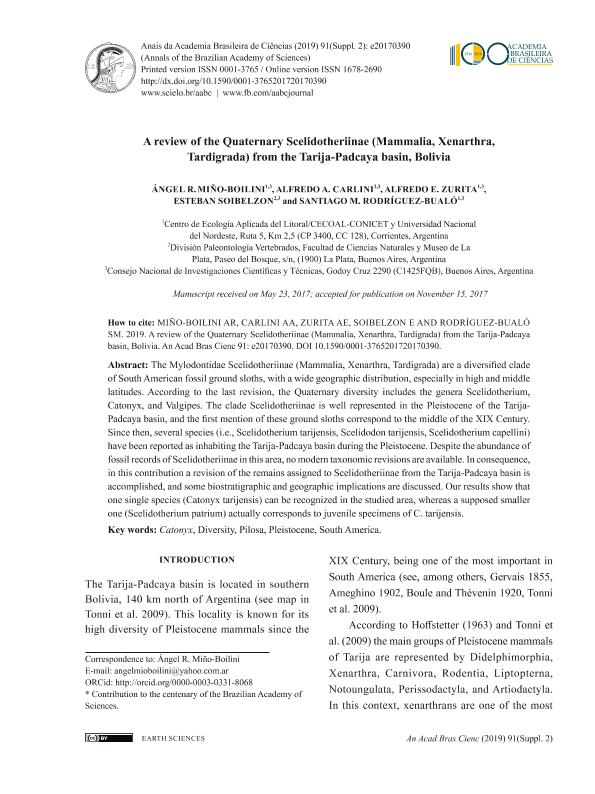Artículo
A review of the Quaternary Scelidotheriinae (Mammalia, Xenarthra, Tardigrada) from the Tarija-Padcaya basin, Bolivia
Miño Boilini, Ángel Ramón ; Carlini, Alfredo Armando
; Carlini, Alfredo Armando ; Zurita, Alfredo Eduardo
; Zurita, Alfredo Eduardo ; Soibelzon, Esteban
; Soibelzon, Esteban ; Rodriguez Bualó, Santiago Martín
; Rodriguez Bualó, Santiago Martín
 ; Carlini, Alfredo Armando
; Carlini, Alfredo Armando ; Zurita, Alfredo Eduardo
; Zurita, Alfredo Eduardo ; Soibelzon, Esteban
; Soibelzon, Esteban ; Rodriguez Bualó, Santiago Martín
; Rodriguez Bualó, Santiago Martín
Fecha de publicación:
04/2018
Editorial:
Academia Brasileira de Ciencias
Revista:
Anais da Academia Brasileira de Ciencias
ISSN:
0001-3765
e-ISSN:
1678-2690
Idioma:
Inglés
Tipo de recurso:
Artículo publicado
Clasificación temática:
Resumen
The Mylodontidae Scelidotheriinae (Mammalia, Xenarthra, Tardigrada) are a diversified clade of South American fossil ground sloths, with a wide geographic distribution, especially in high and middle latitudes. According to the last revision, the Quaternary diversity includes the genera Scelidotherium, Catonyx, and Valgipes. The clade Scelidotheriinae is well represented in the Pleistocene of the Tarija-Padcaya basin, and the first mention of these ground sloths correspond to the middle of the XIX Century. Since then, several species (i.e., Scelidotherium tarijensis, Scelidodon tarijensis, Scelidotherium capellini) have been reported as inhabiting the Tarija-Padcaya basin during the Pleistocene. Despite the abundance of fossil records of Scelidotheriinae in this area, no modern taxonomic revisions are available. In consequence, in this contribution a revision of the remains assigned to Scelidotheriinae from the Tarija-Padcaya basin is accomplished, and some biostratigraphic and geographic implications are discussed. Our results show that one single species (Catonyx tarijensis) can be recognized in the studied area, whereas a supposed smaller one (Scelidotherium patrium) actually corresponds to juvenile specimens of C. tarijensis.
Palabras clave:
CATONYX
,
DIVERSITY
,
PILOSA
,
PLEISTOCENE
,
SOUTH AMERICA
Archivos asociados
Licencia
Identificadores
Colecciones
Articulos(CECOAL)
Articulos de CENTRO DE ECOLOGIA APLICADA DEL LITORAL (I)
Articulos de CENTRO DE ECOLOGIA APLICADA DEL LITORAL (I)
Citación
Miño Boilini, Ángel Ramón; Carlini, Alfredo Armando; Zurita, Alfredo Eduardo; Soibelzon, Esteban; Rodriguez Bualó, Santiago Martín; A review of the Quaternary Scelidotheriinae (Mammalia, Xenarthra, Tardigrada) from the Tarija-Padcaya basin, Bolivia; Academia Brasileira de Ciencias; Anais da Academia Brasileira de Ciencias; 91; Supl. 2; 4-2018; supl. e20170390
Compartir
Altmétricas



